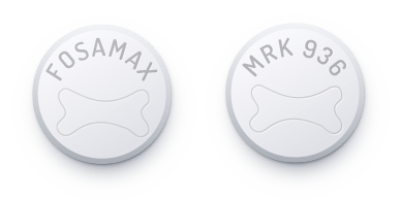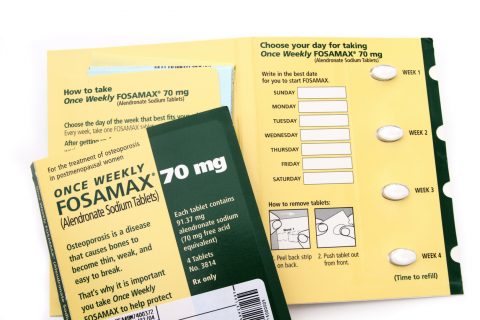Fosamax Safety, Side Effects and FDA Warnings
Fosamax (alendronate sodium) treats osteoporosis and Paget's disease. It has been associated with serious side effects like osteonecrosis of the jaw (ONJ) and femur fractures, leading to FDA warnings and injury lawsuits.
Our content is developed and backed by respected legal, medical and scientific experts. More than 30 contributors, including product liability attorneys and board-certified physicians, have reviewed our website to ensure it’s medically sound and legally accurate.
legal help when you need it most.
Drugwatch has provided people injured by harmful drugs and devices with reliable answers and experienced legal help since 2009. Brought to you by Wilson & Peterson LLP, we've pursued justice for more than 20,000 families and secured $324 million in settlements and verdicts against negligent manufacturers.
More than 30 contributors, including mass tort attorneys and board-certified doctors, have reviewed our website and added their unique perspectives to ensure you get the most updated and highest quality information.
Drugwatch.com is AACI-certified as a trusted medical content website and is produced by lawyers, a patient advocate and award-winning journalists whose affiliations include the American Bar Association and the American Medical Writers Association.
About Drugwatch.com
- 15+ Years of Advocacy
- $324 Million Recovered for Clients
- 20,000 Families Helped
- A+ BBB Rating
- 4.9 Stars from Google Reviews
Testimonials
I found Drugwatch to be very helpful with finding the right lawyers. We had the opportunity to share our story as well, so that more people can be aware of NEC. We are forever grateful for them.
- Medically reviewed by Jessica D. Hess, Ph.D.
- Last update: December 1, 2025
- Est. Read Time: 5 min read
What Is Fosamax and How Does It Work?
Fosamax (alendronate sodium) is a prescription drug primarily used to prevent and treat osteoporosis — a condition that causes bones to become weak and brittle — in men and postmenopausal women. It’s also used to treat Paget’s disease, a disorder that causes weak, soft bones.
The medication was first approved in 1995 and belongs to a drug class called bisphosphonates. Fosamax works by altering the process of bone breakdown to help slow bone loss, increase bone density and prevent bone fractures.
Organon is the drug’s current manufacturer. Merck was the original manufacturer.
Common and Serious Side Effects of Fosamax
According to the drug’s manufacturer, the most common side effects of Fosamax are gastrointestinal issues, including diarrhea, constipation and cramping. Studies show that Fosamax’s side effects range from mild to severe.
Elderly people are more susceptible to side effects from alendronate sodium, especially women who are more prone to developing osteoporosis.
- Bloating
- Bone, muscle or joint pain
- Changes in the ability to taste food
- Constipation
- Diarrhea
- Dizziness
- Gas
- Headache
- Heartburn
- Nausea
- Stomach pain
- Upset stomach
Clinical trial data revealed that adverse reactions, including bone, muscle or joint pain, affect about 4% of people who take Fosamax, but even those issues are rarely severe. Side effects can sometimes occur after commencing treatment. Your doctor may advise you on how to prevent or mitigate some side effects.
Many side effects go away during treatment as your body adjusts to the medication, and most stop immediately after discontinuing the medication. Some people can experience lingering effects for a day or so longer, but those also go away without the drug in their system.
Serious Fosamax Side Effects
Severe side effects of Fosamax include bloody stools, chest pain, difficulty swallowing, skin blisters, eye pain and swelling of your face, throat and tongue.
The U.S. Food & Drug Administration (FDA) documented several of Fosamax’s serious side effects and subsequently distributed numerous warnings to highlight the drug’s potential dangers.
The medication’s insert warns it can lower blood calcium levels because the drug hinders the natural breakdown of bone. Long-term studies showed that calcium in the blood decreased by about 2% in the first month of using Fosamax and suggested adding calcium and vitamin D as supplements.
- Allergic reactions
- Femur fractures
- Itching or eye pain
- Mouth ulcers
- Osteonecrosis of the jaw (ONJ)
- Severe musculoskeletal pain (joints, muscle, bone or jaw)
- Skin blisters
- Sunlight sensitive rash
- Swelling in the face, tongue or throat
The FDA found that Fosamax patients can also develop intense bone, muscle and joint pains days, months or years after starting the drug. For some people, this pain stops almost immediately after discontinuing the medication. For others, the side effects persist.
Peer-reviewed research has also shown a connection between the long-term use of Fosamax and femur fractures. Some people reported unexplained aching in their thigh bones for weeks and months before experiencing unexplained breaks.
Additionally, the common use of bisphosphonates, including Fosamax, caused more awareness of the medication’s link to osteonecrosis of the jaw (ONJ). This is a condition where your gums don’t cover parts of your jawbone. Extensive dental surgeries like tooth extractions and tooth implants, oral infections and conditions like cancer, diabetes and kidney failure heighten the chances of jawbone death.
Femur fractures and ONJ have led people to file Fosamax lawsuits against Merck.
One Woman’s Experience With Fosamax
One patient, identified by her initials C.H. to protect her privacy, told Drugwatch that she suffered ONJ and a thigh bone fracture after taking Fosamax. She has had multiple surgeries and filed a Fosamax lawsuit.
“I didn’t understand until I looked into it more and had a professional explain it to me … Fosamax was supposed to make my bones stronger. In fact, what it does is make them brittle,” she said.
FDA Warnings and Label Changes
The FDA required Fosamax label changes to warn users about ONJ and femur fractures.
Merck first added a warning about ONJ to Fosamax’s label in 2005. This occurred after the FDA cited increasing reports of ONJ in 2004 and urged the drugmaker to make label changes.
In 2010, the FDA required Merck to add warnings about thigh fractures (atypical femur fractures) to the Warnings and Precautions section of Fosamax’s drug label.
Fosamax has been on the market since 1995. Because the ONJ and thigh fracture warnings were not added until 2005 and 2010, respectively, patients and doctors were unaware of these risks for many years.
Fosamax doesn’t have any black box warning for serious side effects that may cause serious harm or death.
Is Fosamax Still Considered Safe?
In general, Fosamax is still considered safe, with a small risk of ONJ and femoral fractures. It remains available in the U.S. in its brand-name and generic forms.
The FDA hasn’t released any information on the ideal duration of Fosamax treatment. At the time of the agency’s 2010 safety communication, evidence showed that bisphosphonates were effective at reducing fractures for at least three years, and in some cases, five years.
A study in JAMA found that the benefits of women taking bisphosphonates tapered off by year seven. The study’s authors said scientists need to do more research on discontinuation times. This could mean that patients may avoid the potential risk of femur fracture or ONJ by stopping the drug after the benefits taper off.
Another review in Stat Pearls suggested giving patients a break from Fosamax treatment. Patients with a low fracture risk could take this break, known as a “drug holiday,” for three to five years. However, for some patients, the benefits of continued therapy outweigh the risk of side effects. The authors suggest that patients have follow-up assessments to measure their bone density and calcium levels at six to 12 months after starting treatment.
Make sure you discuss monitoring your condition with your doctor.
Has Fosamax Been Recalled?
Fosamax has not been recalled in the U.S. The FDA said it would monitor data regarding femur fracture risk in 2010, but there haven’t been any follow-up reports.
What Should You Do if You're Experiencing Side Effects?
If you are experiencing Fosamax side effects, talk to your physician. New thigh or groin pain could be a sign of a femur fracture, and you should notify your doctor immediately. They may recommend tests, such as X-rays, to rule out a femur fracture.
ONJ symptoms can last for eight weeks or longer and include pain and swelling in your mouth. Additionally, part of your jawbone may show through your gums. Your dentist should monitor these symptoms.
You and your doctor can report any side effects to the FDA through its MedWatch Program.
Calling this number connects you with a Drugwatch.com representative. We will direct you to one of our trusted legal partners for a free case review.
Drugwatch.com's trusted legal partners support the organization's mission to keep people safe from dangerous drugs and medical devices. For more information, visit our partners page.





